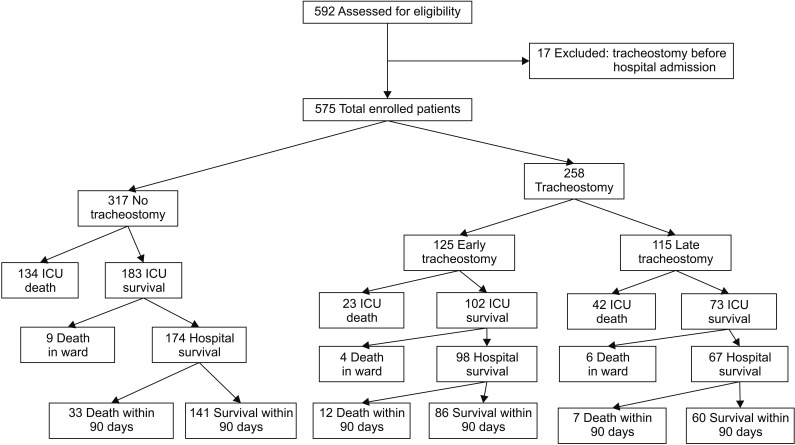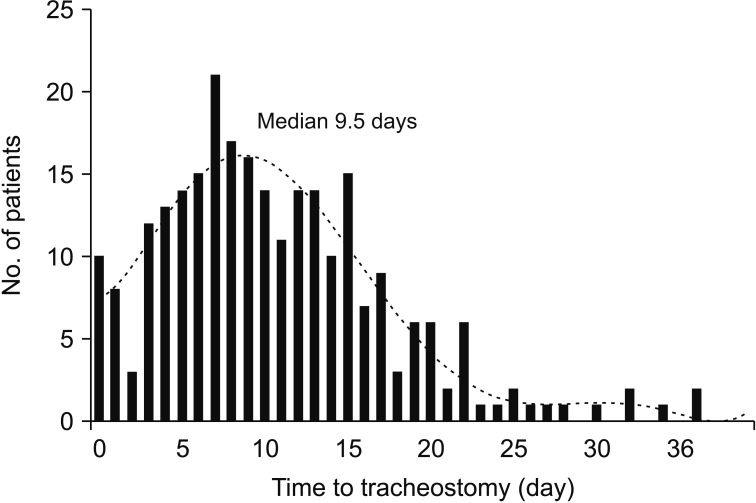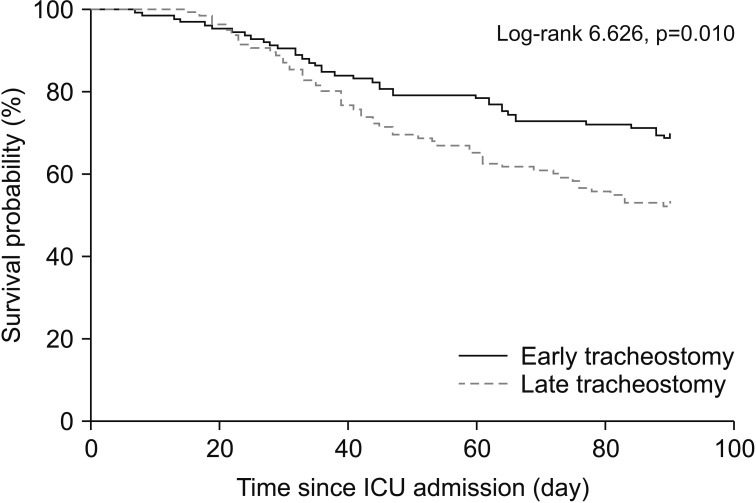Tuberc Respir Dis.
2020 Apr;83(2):167-174. 10.4046/trd.2019.0082.
Effect of Early Tracheostomy on Clinical Outcomes in Patients with Prolonged Acute Mechanical Ventilation: A Single-Center Study
- Affiliations
-
- 1Division of Pulmonary, Allergy, and Critical Care Medicine, Department of Internal Medicine, Pusan National University School of Medicine, Busan, Korea. jubilate@pusan.ac.kr
- 2Department of Trauma Surgery, Pusan National University School of Medicine, Busan, Korea.
- 3Department of Thoracic and Cardiovascular Surgery, Pusan National University School of Medicine, Busan, Korea.
- 4Department of Internal Medicine, Wonkwang University Sanbon Hospital, Gunpo, Korea.
- KMID: 2471893
- DOI: http://doi.org/10.4046/trd.2019.0082
Abstract
- BACKGROUND
The purpose of this study was to investigate the effect of early tracheostomy on clinical outcomes in patients requiring prolonged acute mechanical ventilation (≥96 hours).
METHODS
Data from 575 patients (69.4% male; median age, 68 years), hospitalized in the medical intensive care unit (ICU) of a university-affiliated tertiary care hospital March 2008-February 2017, were retrospectively evaluated. Early and late tracheostomy were designated as 2-10 days and >10 days after translaryngeal intubation, respectively.
RESULTS
The 90-day cumulative mortality rate was 47.5% (n=273) and 258 patients (44.9%) underwent tracheostomy. In comparison with the late group (n=115), the early group (n=125) had lower 90-day mortality (31.2% vs. 47.8%, p=0.012), shorter stays in hospital and ICU, shorter ventilator length of stay (median, 43 vs. 54; 24 vs. 33; 23 vs. 28 days; all p<0.001), and a higher rate of transfer to secondary care hospitals with post-intensive care settings (67.2% vs. 43.5% p<0.001). Also, the total medical costs of the early group were lower during hospital stays than those of the late group (26,609 vs. 36,973 USD, p<0.001).
CONCLUSION
Early tracheostomy was associated with lower 90-day mortality, shorter ventilator length of stay and shorter lengths of stays in hospital and ICU, as well as lower hospital costs than late tracheostomy.
Keyword
MeSH Terms
Figure
Reference
-
1. Ranes JL, Gordon SM, Chen P, Fatica C, Hammel J, Gonzales JP, et al. Predictors of long-term mortality in patients with ventilator-associated pneumonia. Am J Med. 2006; 119:897.
Article2. Holzapfel L, Chevret S, Madinier G, Ohen F, Demingeon G, Coupry A, et al. Influence of long-term oro- or nasotracheal intubation on nosocomial maxillary sinusitis and pneumonia: results of a prospective, randomized, clinical trial. Crit Care Med. 1993; 21:1132–1138. PMID: 8339576.3. Cavaliere S, Bezzi M, Toninelli C, Foccoli P. Management of post-intubation tracheal stenoses using the endoscopic approach. Monaldi Arch Chest Dis. 2007; 67:73–80. PMID: 17695689.
Article4. Cheung NH, Napolitano LM. Tracheostomy: epidemiology, indications, timing, technique, and outcomes. Respir Care. 2014; 59:895–915. PMID: 24891198.
Article5. Aquino Esperanza J, Pelosi P, Blanch L. What's new in intensive care: tracheostomy-what is known and what remains to be determined. Intensive Care Med. 2019; 45:1619–1621. PMID: 31451858.
Article6. Diehl JL, El Atrous S, Touchard D, Lemaire F, Brochard L. Changes in the work of breathing induced by tracheotomy in ventilator-dependent patients. Am J Respir Crit Care Med. 1999; 159:383–388. PMID: 9927347.
Article7. Freeman BD, Morris PE. Tracheostomy practice in adults with acute respiratory failure. Crit Care Med. 2012; 40:2890–2896. PMID: 22824938.
Article8. Hosokawa K, Nishimura M, Egi M, Vincent JL. Timing of tracheotomy in ICU patients: a systematic review of randomized controlled trials. Crit Care. 2015; 19:424. PMID: 26635016.
Article9. Young D, Harrison DA, Cuthbertson BH, Rowan K. TracMan Collaborators. Effect of early vs late tracheostomy placement on survival in patients receiving mechanical ventilation: the TracMan randomized trial. JAMA. 2013; 309:2121–2129. PMID: 23695482.10. Siempos II, Ntaidou TK, Filippidis FT, Choi AM. Effect of early versus late or no tracheostomy on mortality and pneumonia of critically ill patients receiving mechanical ventilation: a systematic review and meta-analysis. Lancet Respir Med. 2015; 3:150–158. PMID: 25680911.
Article11. Andriolo BN, Andriolo RB, Saconato H, Atallah AN, Valente O. Early versus late tracheostomy for critically ill patients. Cochrane Database Syst Rev. 2015; 1:CD007271. PMID: 25581416.
Article12. Szakmany T, Russell P, Wilkes AR, Hall JE. Effect of early tracheostomy on resource utilization and clinical outcomes in critically ill patients: meta-analysis of randomized controlled trials. Br J Anaesth. 2015; 114:396–405. PMID: 25534400.
Article13. Herritt B, Chaudhuri D, Thavorn K, Kubelik D, Kyeremanteng K. Early vs. late tracheostomy in intensive care settings: impact on ICU and hospital costs. J Crit Care. 2018; 44:285–288. PMID: 29223743.
Article14. Shaw JJ, Santry HP. Who gets early tracheostomy? Evidence of unequal treatment at 185 academic medical centers. Chest. 2015; 148:1242–1250. PMID: 26313324.15. Kwak SH, Jeong CW, Lee SH, Lee HJ, Koh Y. Current status of intensive care units registered as critical care subspecialty training hospitals in Korea. J Korean Med Sci. 2014; 29:431–437. PMID: 24616595.
Article16. Lim CM, Kwak SH, Suh GY, Koh Y. Critical care In Korea: present and future. J Korean Med Sci. 2015; 30:1540–1544. PMID: 26538995.
Article17. Acute Respiratory Distress Syndrome Network. Brower RG, Matthay MA, Morris A, Schoenfeld D, Thompson BT, et al. Ventilation with lower tidal volumes as compared with traditional tidal volumes for acute lung injury and the acute respiratory distress syndrome. N Engl J Med. 2000; 342:1301–1308. PMID: 10793162.
Article18. Zollinger RJ, Ellison E. Zollinger's atlas of surgical operations. 10th ed. New York: McGraw-Hill Education;2016.19. Zilberberg MD, Luippold RS, Sulsky S, Shorr AF. Prolonged acute mechanical ventilation, hospital resource utilization, and mortality in the United States. Crit Care Med. 2008; 36:724–730. PMID: 18209667.
Article20. Knaus WA, Draper EA, Wagner DP, Zimmerman JE. APACHE II: a severity of disease classification system. Crit Care Med. 1985; 13:818–829. PMID: 3928249.21. Vincent JL, Moreno R, Takala J, Willatts S, De Mendonca A, Bruining H, et al. The SOFA (Sepsis-related Organ Failure Assessment) score to describe organ dysfunction/failure. On behalf of the Working Group on Sepsis-Related Problems of the European Society of Intensive Care Medicine. Intensive Care Med. 1996; 22:707–710. PMID: 8844239.22. Charlson ME, Pompei P, Ales KL, MacKenzie CR. A new method of classifying prognostic comorbidity in longitudinal studies: development and validation. J Chronic Dis. 1987; 40:373–383. PMID: 3558716.
Article23. Song SE, Lee SH, Jo EJ, Eom JS, Mok JH, Kim MH, et al. The prognostic value of the Charlson's comorbidity index in patients with prolonged acute mechanical ventilation: a single center experience. Tuberc Respir Dis. 2016; 79:289–294.
Article24. Perkins NJ, Schisterman EF. The inconsistency of “optimal” cutpoints obtained using two criteria based on the receiver operating characteristic curve. Am J Epidemiol. 2006; 163:670–675. PMID: 16410346.
Article25. Raimondi N, Vial MR, Calleja J, Quintero A, Cortes A, Celis E, et al. Evidence-based guidelines for the use of tracheostomy in critically ill patients. J Crit Care. 2017; 38:304–318. PMID: 28103536.
Article26. Frutos-Vivar F, Esteban A, Apezteguia C, Anzueto A, Nightingale P, Gonzalez M, et al. Outcome of mechanically ventilated patients who require a tracheostomy. Crit Care Med. 2005; 33:290–298. PMID: 15699830.
Article27. Mehta AB, Syeda SN, Bajpayee L, Cooke CR, Walkey AJ, Wiener RS. Trends in tracheostomy for mechanically ventilated patients in the United States, 1993-2012. Am J Respir Crit Care Med. 2015; 192:446–454. PMID: 25955332.
Article28. Quality of Life After Mechanized Ventilation in the Elderly Study Investigators. 2-month mortality and functional status of critically ill adult patients receiving prolonged mechanical ventilation. Chest. 2002; 121:549–558. PMID: 11834671.
- Full Text Links
- Actions
-
Cited
- CITED
-
- Close
- Share
- Similar articles
-
- Impact of tracheostomy on clinical outcomes in ventilated patients with severe pneumonia: a propensity-matched cohort study
- Outcomes in Relation to Time of Tracheostomy in Patients with Mechanical Ventilation
- The Effectiveness of Early Tracheostomy (within at least 10 Days) in Cervical Spinal Cord Injury Patients
- Comparison of Clinical Outcomes of Early and Late Tracheostomy
- The Effects of Early Tracheostomy in Flame Burned Patients with Inhalation Injury




